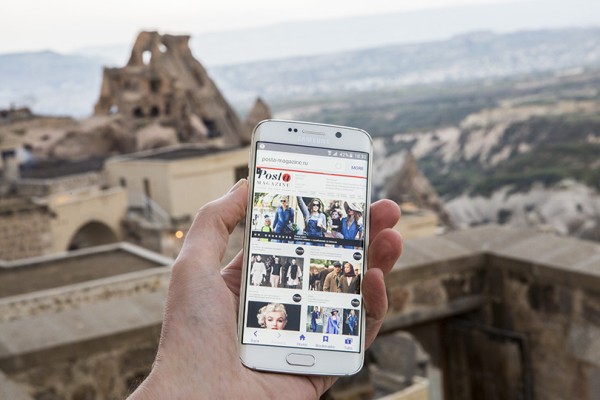In today’s material
we will try to consider features of Samsung Galaxy S6 edge
and Apple iPhone absolutely impartially.
I’ll start off by being honest: I’ve never owned a Samsung phone before. Nor have I ever owned an Apple iPhone. I’ve tried all of them many times, of course, but I never really liked any of them. That’s how we humans are, we have strange tastes and preferences that cannot be objectively quantified. Ask 10 people to test the latest Mercedes and BMW cars and half of them won’t agree with the other give on which car is best.
Anyway, never having owned either a Samsung Galaxy phone nor an Apple iPhone I believe I went into this test with a pretty clear and open mind. Although I’d like to point out that it is not my intention to actually review an iPhone here. It’s just that, love it or hate it, the iPhone is considered to be the benchmark for all other high end smartphones. It has a reputation for being the best phone and a well deserved one at that. Considering that the Galaxy S6 costs about the same as an iPhone you just can’t avoid the comparison.
The only other phone I can really compare the new Samsung to is my old HTC One M7 which I’ve owned for nearly 2 years now. It might seem that this is an unfair comparison considering how old my HTC is, but in reality I’m doing HTC something of a favor here. Because with each new slightly newer version of the One they’ve actually managed to make it worse. In particular the quality of the screen which is of great importance to me as a photographer.
![]()
Samsung actually caught us a bit by surprise when they announced the S6 — by announcing two phones rather than one. There’s the regular S6, and the S6 «edge». To keep the explanation as simple as I can: the normal S6 is a phone like any other but the S6 edge has a screen that curves down the sides of the phone. It’s pretty unusual looking in a good way, and I can report it draws quite a bit of attention from people who normally wouldn’t be interested in phones much.
![]()
Regular Galaxy S6 on the left, edge on the right
Other than the unusual curved screen on the S6 edge, the two S6 phones are pretty much identical in terms of technology. They have the same hardware and even the screens have virtually the same specifications if we ignore shapes. So if you want to buy either of these but aren’t quite sure, just go to a shop and hold them both. Because other than personal preference there isn’t really a deciding factor. Well, I should add that the regular S6 is quite a bit less expensive than the edge. So that’s worth keeping in mind.
The first thing I noticed — and liked — about the Galaxy S6 Ege is that the physical format of the phone isn’t really that big. It’s hardly any bigger than my HTC One or the iPhone. Except both those phones have a 4.7 inch screen and the S6 has a 5.1 inch screen. Very little space has gone to waste here, it’s a large and beautiful looking screen without much fat around it. I admit to having pretty large hands, but I find the size of the phone very comfortable.
![]()
The screen itself is pretty much the most important piece of any smartphone and Samsung has absolutely hit the ball out of the park with its latest effort. The Super AMOLED screen has a resolution of 2560 by 1440 pixels, meaning it has a staggering 557 pixels per inch. This phone effectively has the same amount of pixels as my 27 inch computer monitor. Which is an amazing achievement which would have seemed impossible only a few years ago. To put it in perspective, that’s over 40 percent more pixels than a Full HD television has. It’s a lot for a 5.1 inch screen and probably more than you need. But there’s no denying how good this screen looks.
AMOLED screens have the advantage of being able to produce really black blacks. With TFT screens the problem you have is that the backlight of the screen shines through areas of the screen that are trying to display black. So what you really see is a pretty dark gray, never actual black. Because AMOLED pixels are responsible for displaying colours but also to generate the light itself, they can be turned off and display nearly true black. The greater contrast this provides is very noticeable, it almost makes pictures look better than they really are. Or at least better than they look on your computer screen.
![]()
Looking at a shot made by the S6 edge’s own camera
Colours are rich and vivid, but traditionally AMOLED has lagged behind a bit in terms of colour accuracy. The Apple iPhone has always had excellent scores in that department and this has probably motivated Samsung to do better this time around. And I’m happy to report the colour temperature and accuracy on the new S6 are indeed excellent. Add the fact that the maximum brightness has also increased over previous models — very important for viewing in sunlight — and I think it’s fair to say the Galaxy S6 has the best screen on the smartphone market today. It has no equal in terms of resolution and contrast yet still manages to be about as good as any other for colour accuracy and brightness. It’s a huge accomplishment for Samsung’s display department, and it also illustrates the advantage of being able to manufacture your own screens.
If you dig into the basic settings for the S6, you can not only change the brightness level of the screen but also the way the colours are displayed. The «basic» and «photo» settings offer very realistic colours — whereas the «cinema» setting creates colours that look better to most people even though they aren’t the most accurate. I think this is a great choice to have, although most people who aren’t photographers are probably never going to touch this one.
![]()
Speaking of photography, the second biggest achievement on the Galaxy S6 series is the camera. Even though I have a large professional camera with me much of the time, snapping a quick picture with your phone is just so convenient. Samsung has fitted a 16 megapixel camera on the back and the lens has a maximum aperture of F/1.9. For comparison, the iPhone 6 has a lens which goes up to F/2.2 and the smaller the F number the more light can enter through a lens. So we expect the Samsung to have a lens advantage when conditions are quite dark. The camera on the S6 has twice as many pixels as the iPhone 6 as well, but one should be careful not to draw any premature conclusions from that fact. The HTC One M9 for example boasts a 20 megapixel camera which is frankly crap and nowhere near as good as the 8 megapixel iPhone. The size of the sensor and its individual pixels plays a big role, as does the quality of the lens and the camera software itself.
The camera app on the Samsung S6 works very fast and is generally easy to use. It has different «modes» from slow-motion video to a «pro» camera setting where you can manually change things like exposure and ISO. Which is very handy but if there is one thing I’d like to ask for it would be the ability to create RAW images which are more suitable for post processing on a computer afterwards. This feature is absent from smartphones generally, but it is technically possible to add since Google added RAW support to Android a few months ago. Hopefully a future update will unlock this capability.
![]()
That said, there is absolutely nothing wrong with the standard JPEG images which roll out of the Galaxy S6. And probably because the screen is so good, Samsung has opted for very natural looking pictures. They are very close to what the eye sees. We can again say that this is pretty much the best camera on any smartphone on sale today. It’s not twice as good as the iPhone camera, but it is visibly better with more detail. Keep in mind that the camera on the iPhone is already pretty good,maybe the best until now. The quality of the pictures delivered by the Samsung Galaxy S6 is such that I see very little point anymore in having a small compact camera. Either bring a big DSLR or just use your phone. You can have a look at the sample images I’ve created with the Galaxy S6 and iPhone 6. Particularly in close-up situations the Galaxy S6 takes a massive lead in image quality. In larger scenes the difference isn’s as pronounced but the extra pixels still mean that you can easily read letters on far away signs which are unreadable on the pictures made by the iPhone.
![]()
Almond tree blossom close-up by the Galaxy S6 edge (top) and iPhone 6 (bottom)
![]()
100% crop shot from the same distance. Samsung on the left, Apple on the right
Of course it’s also important to see what camera performance is like in very dark conditions, and in the wine cellar shot below you can see the advantage of the lens on the Galaxy S6. It allows the phone to keep the ISO value low in order to avoid excessive sensor noise. It’s also clear that the S6 uses longer shutter openings, again allowing more light to hit the sensor. This is explained by the fact that the Samsung has optical image stabilization, a feature the iPhone 6 lacks. This feature, by the way, is actually present in the iPhone 6 plus but not the smaller model. It’s another win for Samsung which has moved the bar up a few notches for phone cameras. If there is one negative I should point out it is that I find the white balance in low light better on the iPhone. Skin colour is represented better by the Apple in these conditions. It’s not a huge difference, and you can adjust this easily in the S6, but it’s worth mentioning.
![]()
Wine cellar picture in low light. Samsung is once again on the left and Apple on the right
For the front camera — in case any selfie queens are reading this — it’s pretty much the same story. Another F/1.9 lens is on the front with a 5 megapixel sensor capturing your own face in random locations. This compares to the iPhone’s 1.2 megapixsel sensor and F/2.2 lens, and the initial impression is that the Samsung has a similar advantage here in terms of outright image quality. Not like you’d notice this on Instagram* (*Meta Platforms Inc. (Facebook, Instagram) — организация, деятельность которой признана экстремистской, запрещена на территории Российской Федерации) of course. So I personally wouldn’t care too much about the difference.
One feature where the iPhone definitely beats the Samsung Galaxy is slow motion video. The Samsung only goes up to 120 frames per second — in other words you can slow the video down by a factor of four — whereas the iPhone can go up to 240 frames per second. Basically the slow motion video can run twice as slow when shot with the Apple phone. So there you go, there’s always room for improvement. Though the Galaxy S6 camera fights back with the ability to record very high resolution video. The iPhone shoots up to 1080p HD video but the S6 will go all the way up to «ultra HD 2160p» which is four times as many pixels. Four times! Useful feature? Probably not. But people like big sounding numbers I suppose.
Battery life is another crucial aspect of any smartphone, and one where I cannot say Samsung has made any great improvements over previous models. I would classify battery life as «fine». I’ve not done any outright scientific testing of battery life in all conditions and applications, but it certainly isn’t bad. About the same as the iPhone. I just wish manufacturers would stop chasing the thinnest possible phone and instead make something that we can use for longer without having to plug it in. The need to charge a mobile phone makes it a lot less…mobile. So please Samsung, Apple, HTC and everyone else: just give us a normal sized phone which is a little bit thicker but with a long lasting battery. I think it would be worth it.
But even though it runs out of power as quickly as the competition, the S6 does charge pretty quickly. An adaptive fast charger is supplied with the phone and you can go from empty to 50% in about half an hour. The phone also has integrated wireless charging capability. So if you buy a wireless charger to put on your desk at home or at work, you don’t need to keep plugging in your phone all the time. Just place it on top of the charger whenever you’re not using it. It’s a lovely feature, it’s just a shame hardly anyone will ever use it. They really ought to simply include a wireless charger with the phone because hardly anyone will go out and buy one. Many will not even know it exists.
![]()
Build quality is another area where Samsung has made great strides forward recently. It’s not that they thought about it first, but the market has been going in a direction where people are expecting phones that feel well built. After all, these phones all cost a considerable amount of money so you don’t want it to feel like cheap plastic. Apple has been doing this pretty much from the beginning, but if I had to guess I think it was the success of the aluminium-bodied HTC One phones that made Samsung sit up and take notice. You can’t achieve a «premium» feeling phone with plastic and composits. The new Galaxy S6 finally feels as expensive as it is. Front and back are all glass, which is an issue for leaving visible fingerprints all over it but otherwise it’s really a quality finish. As always with new product launches, the glass is said to be harder and tougher than ever before. I still wouldn’t suggest dropping it. A metal strip surrounds the edges of the phone so every material you touch feels solid and nice.
![]()
Using the software on the phone is really something I can’t describe as easily as some of the other features. If you’re used to Apple’s iOS then Android will probably feel a bit strange and unintuitive to you. I believe this to be a matter of habit, if you use something for a while you’ll get used to it and any unfamilar OS will feel strange to you. Compared to other Android phones, Samsung has traditionally not had the best received interface. Too many apps that you really didn’t need or want came pre-installed from the factory and the menus tended to be confusing rather than helpful. Again, Samsung appears to have heard the complaints and made considerable improvements. I have no complaints about it, even if I probably still prefer HTC Sense. Then again, in time I may change my mind. I do like having things like WiFi and screen brightness right in the pull-down menu.
Any other features worth mentioning? Well the fingerprint sensor actually works very quickly, as quick as the one on the iPhone. I never considered this a must-have feature on a phone to be honest, but I do find myself using it if it’s there. Styling wise you would have to say the S6 edge is the one to go for, but the narrow edges of the phone make it somewhat less pleasant to hold than the regular S6. But then the regular S6 looks a lot more like an iPhone to me. No bold styling from Samsung on that one. Whether or not that bothers you I don’t know. But for me, if you want to be a little bit different, the unusual screen design of the S6 edge has won me over. Sometimes you just want something pretty even if it doesn’t make any practical sense. And there’s one seemingly worthless feature which I really enjoy: the night clock. The edge of the curved screen is ideal for displaying the time at night. I’ve found myself waking up during the night and just looking at the phone next to the bed is enough to see the time. It sounds pointless but I really quite like it.
![]()
А night clock can be displayed on the side of the S6 edge, along with other notifications
The thing is, smarphones are really mini computers so packed with functionality that we can go on for pages and pages until we’re all asleep from boredom. There’s countless features I haven’t mentioned because, well, there’s just too many which most people will never use. NFC and mobile pay solutions is something both Apple and Samsung are getting into but it’s just not really caught on yet. The Galaxy S6 also comes with a health app which will measure your heart rate and count your steps — and congratulates you on your achievements. Don’t see myself using that one too much either. Oh and you can use the phone it to call people too, if anyone’s still interested in that.
I don’t do star ratings, nor will I score the Samsung Galaxy S6 edge a number out of 10. What I will say is that this phone is, in my opinion, the most technologically impressive phone on sale today. It exceeds expectations and is a true step forwards in nearly all areas. It was exactly what Samsung needed to do after less than stellar sales of the previous model, the Galaxy S5. In the Android universe, Samsung is once again on top of the pile. Whether they manage to lure some people away from Apple’s iPhone remains to be seen, as this is really more a matter of preference rather than an outright technical battle. Apple’s iOS is probably still more user friendly for people who aren’t going to go far beyond the basic smartphone functionality. If you’re a bit more of a power user and like the extra features Samsung and Android are offering, the Galaxy S6 edge is the new king of the hill.
Now if you’ll excuse me, I have to take this call.
![]()











